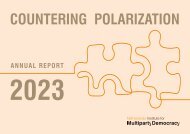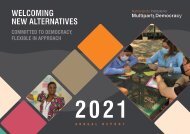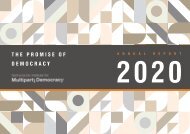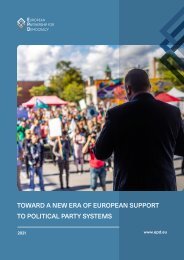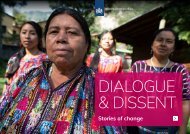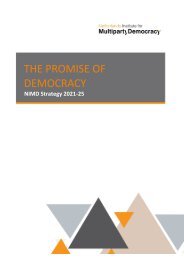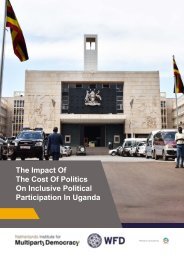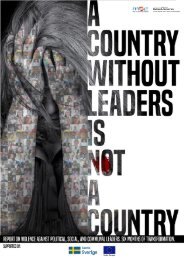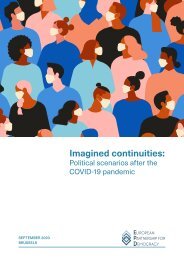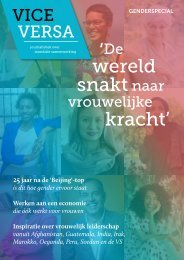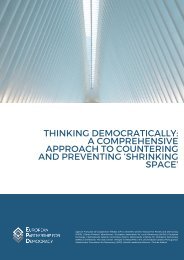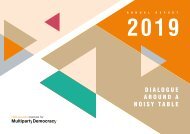Repression and resilience: Diagnosing closing space mid-pandemic
Create successful ePaper yourself
Turn your PDF publications into a flip-book with our unique Google optimized e-Paper software.
REPRESSION AND RESILIENCE: DIAGNOSING CLOSING SPACE MID-PANDEMIC<br />
9<br />
st<strong>and</strong> a real chance of winning future elections. It<br />
also requires a pluralistic media <strong>and</strong> information<br />
environment with equal opportunities for competing<br />
over public opinion.<br />
• Checks <strong>and</strong> balances safeguard the separation of<br />
powers <strong>and</strong> accountability mechanisms between<br />
the different democratic institutions <strong>and</strong> particularly<br />
between the executive, legislative <strong>and</strong> judiciary<br />
branches of government. An institutional structure<br />
of checks <strong>and</strong> balances requires an independent<br />
judiciary, a well-functioning legislature <strong>and</strong> the rule<br />
of law.<br />
This conceptual framework was further tested <strong>and</strong><br />
refined through the 9 country case studies conducted in<br />
2020, leading to new insights based on the p<strong>and</strong>emic <strong>and</strong><br />
to a reinforced underst<strong>and</strong>ing of the tactics employed in<br />
<strong>closing</strong> <strong>space</strong>. 8<br />
Three pillars of democratic <strong>space</strong> - before<br />
<strong>and</strong> during the p<strong>and</strong>emic<br />
Attacks on democratic <strong>space</strong> can similarly be categorised<br />
into 3 tactics based on the 3 pillars: <strong>closing</strong> civic <strong>space</strong>;<br />
creating an uneven playing field; <strong>and</strong> undermining checks<br />
<strong>and</strong> balances. This section summarises the variety of<br />
tactics for <strong>closing</strong> democratic <strong>space</strong> under each pillar<br />
<strong>and</strong> details examples of what these traditional tactics of<br />
<strong>closing</strong> <strong>space</strong> looked like during the p<strong>and</strong>emic.<br />
1. Civic <strong>space</strong><br />
Closing <strong>space</strong> is most often understood as attacks on<br />
civic <strong>space</strong> more narrowly, encompassing the various<br />
legal, administrative, extra-legal <strong>and</strong> political measures<br />
to limit freedom of expression, press, assembly <strong>and</strong><br />
association. Such attacks thereby inhibit free democratic<br />
debate <strong>and</strong> the proper functioning of media outlets,<br />
emerging political (opposition) forces, <strong>and</strong> civil society<br />
organisations (CSOs). 9 According to the Varieties of<br />
Democracy Institute, threats to freedom of expression<br />
<strong>and</strong> the media have intensified in the greatest number<br />
of countries over the last decade, while repression of civil<br />
society has worsened substantially in 50 countries over<br />
the past ten years. 10<br />
Legislative restrictions: In recent years, at least 50<br />
countries have implemented legislative measures<br />
that interfere with the right to freedom of association,<br />
restricting the work of CSOs <strong>and</strong> the individuals involved<br />
in civil society actions. 11 These laws often target CSOs<br />
by restricting their operational environment through<br />
administrative, registration, <strong>and</strong> funding requirements.<br />
Other measures effectively silence specific voices deemed<br />
to be unacceptable such as the LGBTQI community <strong>and</strong><br />
women, for example by criminalising content shared by<br />
those same voices on the basis of vague norms. The EU’s<br />
Fundamental Rights Agency <strong>and</strong> Amnesty International<br />
have both documented similar obstacles to a conducive<br />
12 13<br />
regulatory environment for civil society in Europe.<br />
During the p<strong>and</strong>emic, many limitations were placed on<br />
freedom of movement <strong>and</strong> assembly, thereby adopting<br />
measures that effectively limit civic <strong>space</strong>. While many<br />
of the restrictions were justified by the p<strong>and</strong>emic,<br />
others were not. Many journalists, for instance, found<br />
themselves unable to accurately report the news due<br />
to curfews, <strong>and</strong> were subjected to police brutality when<br />
8 The case studies were chosen to represent a diversity of regime types <strong>and</strong> experiences of <strong>closing</strong> <strong>space</strong>. Building on the expertise gathered<br />
through the previous case studies in 2017-2019, 5 case studies were updated to enable a strong comparison between the pre- <strong>and</strong> <strong>mid</strong>-p<strong>and</strong>emic<br />
situation. This was complemented with 4 specific cases that added a new dimension to the analysis: a post-conflict country (Colombia),<br />
a country with an institutional crisis (Venezuela), <strong>and</strong> 2 countries where elections were held during the p<strong>and</strong>emic (Ug<strong>and</strong>a, Burundi).<br />
9 CIVICUS (2018): What is civic <strong>space</strong>? Available here.<br />
10 V-Dem (2021): Autocratization Turns Viral - Democracy Report 2021. Available here.<br />
11 European Parliament (2017): “Shrinking <strong>space</strong> for civil society: The EU response.” Available here.<br />
12 EU Agency for Fundamental Rights (2018): Challenges facing civil society working on human rights in the EU. Available here.<br />
13 Amnesty International (2019): Laws designed to silence: The global crackdown on civil society organisations. Available here.




